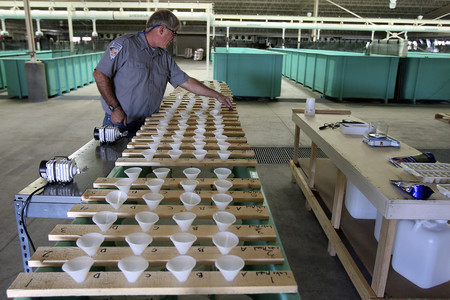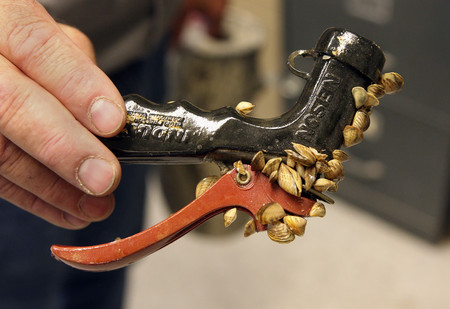Putting Pests to Test
Quagga mussels have invaded Lake Mead by the trillions, but that doesn't mean no good can come of it. Researchers are now turning Lake Mead's fish hatchery into a laboratory to understand how the pesky mollusks could impact other Western waters.
Tanks, or raceways, have been drained and trout production halted ever since Nevada Department of Wildlife biologists realized two years ago that lake water for raising trout was contaminated with the tiny quaggas.
Until a new water supply can be developed -- one that uses mussel-free, treated lake water -- part of the hatchery with its microscopes and laboratory facilities has been temporarily converted into an experimental station to predict how quaggas will fare if they turn up in the Pacific Northwest, for example.
"Our water is contaminated. We're letting the scientific community come in as much as they can," Hatchery Manager Clyde Parke said while working Thursday inside the hangarlike building on a hill overlooking Lake Mead's Las Vegas Bay.
Jon Sjoberg, Nevada's Southern Region supervising fisheries biologist, said the hatchery's mussel problem "is a bad situation, but at least we can get some benefit out of it."
"We have an opportunity to help out with some research. It was basically no cost to us, because we've got mussels," Sjoberg said.
The first of what wildlife officials expect could be several more studies was wrapped up last month by Portland State University researcher Brian Adair.
Working under a $165,000 grant from the Bonneville Power Administration, Adair and research assistant Jessica Durst set out to determine if quagga mussels can survive and grow in Columbia River water.
"What we're really interested in finding out about is how calcium in the water affects the mussels' ability to grow," Adair said by telephone.
The mussels need calcium to grow shells, vital for populations to thrive as dense colonies. Lake Mead water contains about three times more calcium than Columbia River water.
Water managers in the Pacific Northwest are worried that quaggas might eventually show up there. In May 2006, months before biologists realized Lake Mead had been infested with quagga mussels, a load of 16,000 rainbow trout along with water from the hatchery, possibly containing larvae or adults quaggas, was poured into Wild Horse Reservoir in Northern Nevada. The reservoir is on the Owyhee River drainage that's part of the Columbia River basin.
In their experiment, Adair and Durst extracted 200 gallons from the Columbia River at Cascade Locks, about 50 miles east of Portland. The water was trucked to the Lake Mead hatchery in five-gallon plastic jugs. Some of it was used to fill nearly 100 pint-sized plastic cups, each holding a single, juvenile quagga as small as a child's fingernail. One set contained pure Columbia River water. In the other sets, calcium was added in increased increments.
Another two dozen cups, each with a quagga, were filled with Lake Mead water to serve as a control for comparing mortality rates.
Conditions were created for mussels to survive. Ice cubes frozen with algae were placed in funnels above the cups. When the ice cubes melted, algae dripped down to nourish the mussels. Oxygen was also bubbled into the cups, because the mussels extract oxygen from water.
After running the experiment for 30 days, Adair observed a 67 percent mortality rate in pure Columbia River water. Those kept in Lake Mead water with much higher calcium content had only a 25 percent mortality. That's what scientists expect when mussels are taken from their natural settings and handled.
Despite the fact that quaggas didn't fare well in Columbia River water, Adair said he still is leery of the potential impact from quaggas if they reach the river or its tributaries.
Another round of experiments is planned for January to surround cups containing quaggas in lake water at a cooler temperature more conducive for quagga growth. He is hoping quaggas in cups of Columbia River water won't grow fast or at all.
"If that's the case, that's when we'll breathe a sigh of relief," he said.
Damage caused by non-native quaggas and their zebra mussel cousins to water systems and marine equipment has been known for two decades after their North America invasion began in the Great Lakes region.
Quaggas, which are a different but similar species to zebra mussels, were so named after an extinct mammal that resembled a zebra but bore stripes only on the front of its body and head.
Quagga and zebra mussels were first noticed in the Great Lakes in the mid-1980s, when they escaped in ballast water carried by ships from the vicinity of Ukraine's Dneiper River drainage, where they are native.
Quaggas spread rapidly. Biologists think they arrived at Lake Mead a few years ago by hitchhiking in bilge water or equipment of a boat from the Midwest. Since they were discovered in Lake Mead on Jan. 6, 2006, they have taken hold downstream in lakes Mohave and Havasu and waterways in Southern and Central California.
Their population numbers jumped from 47.8 billion in 2007 to 2.9 trillion in Boulder Basin alone last year.
They have begun to impact the lake's ecosystem at a fast rate while clogging water pipelines and encrusting boats and marine equipment. The costs for maintaining water intakes, marine structures and watercraft in Lake Mead National Recreation Area already are more than $1 million yearly.
David Wong, a University of Nevada, Las Vegas expert on quaggas, said they live in Lake Mead for about 21/2 years before they die off, usually at the end of summer after water temperatures a few feet below the surface hit 90 degrees and they experience a dormant state that makes their bodies fragile.
Natural die-off of the first generation occurred last summer in Lake Mead. A second die-off occurred at the end of this summer.
Wong said scientists will be watching as die-offs occur in future years to assess how such events will affect the lake's ecosystem.
Contact reporter Keith Rogers at krogers @reviewjournal.com or 702-383-0308.


















